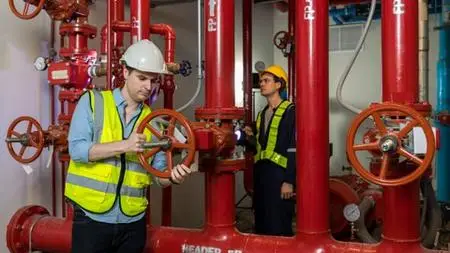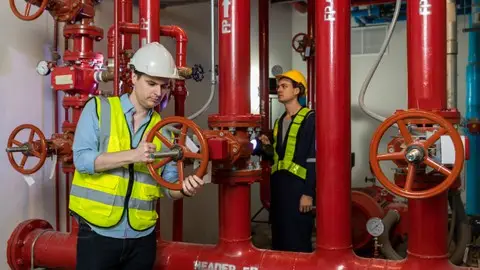Fire Systems Design Course For Safety And Protection
Published 6/2023
MP4 | Video: h264, 1280x720 | Audio: AAC, 44.1 KHz
Language: English | Size: 5.44 GB | Duration: 14h 36m
Published 6/2023
MP4 | Video: h264, 1280x720 | Audio: AAC, 44.1 KHz
Language: English | Size: 5.44 GB | Duration: 14h 36m
Master the Art of Fire Protection: Designing Safety & Protection Systems
What you'll learn
Understand the principles of fire protection systems
Design effective fire protection systems
Ensure compliance with fire safety codes and regulations
Optimize system performance and efficiency
Requirements
Engineering or technical background
Proficiency in mathematics
Basic understanding of building construction
Description
The "Fire Systems Design Course for Safety and Protection" is a comprehensive and in-depth program designed to equip learners with the knowledge and skills necessary to design robust fire protection systems. With a focus on safety and protection, this course delves into the principles, methodologies, and best practices involved in designing effective fire systems tailored to specific environments.Throughout the course, learners will explore various aspects of fire systems design, starting with a solid foundation in fire science. They will gain a deep understanding of fire behavior, combustion principles, and fire dynamics, enabling them to make informed decisions when designing fire protection systems. Building upon this knowledge, learners will delve into the intricacies of fire protection system components, including fire alarms, sprinkler systems, detection systems, and suppression methods.One of the key objectives of the course is to develop learners' ability to analyze fire risks and implement preventive measures. Through engaging lessons and practical exercises, participants will learn how to conduct comprehensive risk assessments, identify potential fire hazards, and develop strategies to minimize risks and enhance overall fire safety. They will also explore the selection and application of appropriate fire suppression methods, such as water-based systems, gaseous agents, and foam systems, based on the specific requirements of different fire scenarios.A massive portion of the course is dedicated to compliance with fire safety regulations, codes, and standards. Learners will familiarize themselves with national and international codes, guidelines, and fire protection systems design standards. They will understand the importance of adhering to these regulations and learn how to integrate them into the design process, ensuring that their fire protection systems meet the required legal and safety standards.The course also emphasizes the integration of fire protection systems with building design. Learners will explore the architectural considerations necessary for seamless integration, including compartmentalization, fire-resistant materials, and egress design. By understanding the relationship between fire systems design and building layout, participants can create effective fire protection solutions that align with safety requirements and aesthetic considerations.Throughout the course, learners will have the opportunity to apply advanced fire modeling and simulation techniques. They will gain hands-on experience using industry-leading software tools to analyze fire behavior, simulate evacuation scenarios, and optimize system performance. By leveraging these technologies, participants will be able to make informed decisions in fire systems design, ensuring the effectiveness and efficiency of their solutions.By the end of the course, learners will have a comprehensive understanding of fire protection systems design, enabling them to design efficient, reliable, and compliant fire protection systems tailored to specific environments.Join us in mastering the art of fire protection and designing safety and protection systems that make a difference. Enroll in the "Fire Systems Design Course for Safety and Protection" and embark on a journey towards creating safer environments and safeguarding lives and property.
Overview
Section 1: Introduction to Fire
Lecture 1 Basics of Fire
Lecture 2 Classification of Fire
Lecture 3 Controlling Hazard
Section 2: Fire Fighting and Protection
Lecture 4 Methods and Equipment in Fire Fighting
Lecture 5 Fire Protection System
Lecture 6 Active Fire Protection System
Lecture 7 Passive Fire Protection System
Section 3: Fire Detection and Alarm System
Lecture 8 Fire Alarm System
Lecture 9 Fire Detection System
Section 4: Fire Extinguishers
Lecture 10 Basics of Fire Extinguishers
Lecture 11 Types of Fire Extinguishers
Lecture 12 Fire Extinguishers Location and Placement
Lecture 13 Selection of Fire Extinguishers
Lecture 14 Fire Extinguishers Inspection, Testing and Maintenance
Lecture 15 Using Fire Extinguishers
Section 5: Water Based Fire Protection Systems
Lecture 16 Water Distribution System
Lecture 17 Pipes and Fittings
Lecture 18 Valves and Hydrants
Lecture 19 Water Tank Connections
Section 6: Fire Water Pumps
Lecture 20 Fire Pump
Lecture 21 Positive Displacement Pump
Lecture 22 Centrifugal Pump
Lecture 23 Jockey Pump
Lecture 24 Fire Pump Room
Section 7: Sprinkler System
Lecture 25 Working of Fire Sprinklers
Lecture 26 Characteristics of Fire Sprinklers
Lecture 27 Fire Sprinkler Heads
Lecture 28 Fire Sprinkler System
Lecture 29 Sprinkler K-factor
Section 8: Types of Sprinkler System
Lecture 30 Overview of Various types of Fire Sprinkler System
Lecture 31 Wet Pipe and Dry Pipe Sprinkler Systems
Lecture 32 Pre Action and Deluge Sprinkler System
Section 9: Design of Sprinkler System
Lecture 33 Sprinkler System Design Steps Part 01
Lecture 34 Sprinkler System Design Steps Part 02
Lecture 35 Hydraulic Calculation Methods
Lecture 36 Fire Sprinkler Design for an Office Building
Fire Protection Engineers,Fire Safety Engineers,Architects and Building Design Professionals,Fire Safety Inspectors and Code Officials,Facility Managers and Safety Officers



